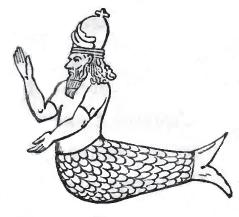He links mermaids and mermen to solar gods. Sun and moon gods and goddesses were often depicted as having fish tails, because in the view of ancient people, the sun and moon appeared to arise from the sea each day, and then plunge back into the sea. A creature spending half of their time in water and half in the air would have to have a body to accomodate both.
Early mermaid history also contains stories such as that of Melusina and Undine. Baring-Gould gives us the skeletal outline of such stories:
1. A man falls in love with a woman of a supernatural race
2. She consents to live with him, subject to one condition
3. He breaks the condition and loses her
4. He seeks her-and at this point the story can go one of two ways, he either finds her and secures a happy ending, or loses her.
This storyline strikes me especially because I'm also in the midst of reading Maria Tatar's Secrets Beyond the Door: The Story of Bluebeard and His Wives, in which Tatar points out that most versions of Bluebeard, as well as older myths and stories such as Cupid and Psyche, Pandora, and the biblical Eve, condemn women who are too curious, and associate knowledge with sin, but only when applied to women.
Yet here we have the opposite storyline-much like a role-reversed Cupid and Psyche or Animal Bridegroom tale, the man is usually forbidden to look at his beautiful wife under certain conditions. Just like Psyche, he is eventually persuaded to break his promise and satisfy his curiosity, and just like Psyche he suffers for it. Although I doubt anyone would conclude from the tale of Melusina that men are condemned who seek knowledge...(largely because tales such as these are the exception and not the rule, although I wonder how widespread this tale type was in earlier centuries compared to those that either imply or outright condemn female curiosity?)
Elenore Abbott
One of the things that always fascinates me about mermaids and faerie stories are how widespread belief in them was at one time. Baring-Gould says that belief in mermaids is universal. In my earlier posts Historical Evidence for Mermaids, I list several supposed "mermaid sightings" that have been recorded in history, with specific times, locations, and people. I won't do that again, but Baring-Gould lists several other similar "sightings", from as early as 1187 and through the eighteenth century. Interesting reading, even for the skeptical...



I've always liked the explanation of mermaids/selkies at the Orkneyjar site: http://www.orkneyjar.com/folklore/selkiefolk/origins/origin5.htm
ReplyDeleteThe whole section on the tales and historical roots of selkies, mermaids and finfolk is worth reading.
I love your site. You have a wonderful collection of interesting artifacts regarding folklore, and I have enjoyed spending time here.
ReplyDeleteJust a note, however, you refer to Sabine Baring-Gould as a "she," when in fact, Sabine was a gentleman.
http://www.sbgas.org/
Whoops!! Thank you for letting me know, I've updated the post now!
Delete